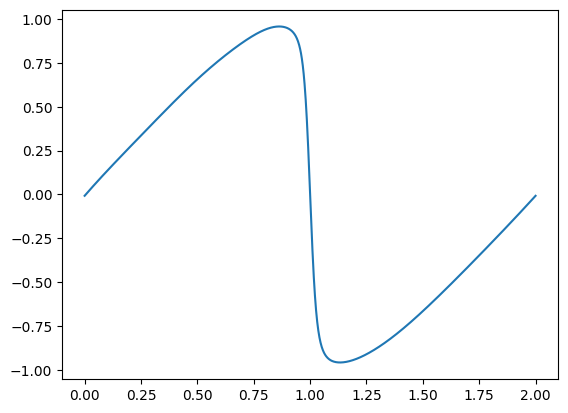神经网络解偏微分方程
1
2
3
| import torch.nn as nn
import torch
from torch.autograd import Function
|
1
2
3
4
5
6
7
8
9
10
11
12
13
14
15
16
| class NN(nn.Module):
def __init__(self):
super(NN, self).__init__()
self.input_layer = nn.Linear(2, 20)
self.hidden_layer = nn.ModuleList([nn.Linear(20, 20) for _ in range(4)])
self.output_layer = nn.Linear(20, 1)
self.act = nn.Tanh()
def forward(self, x):
o = self.act(self.input_layer(x))
for _, hl in enumerate(self.hidden_layer):
o = self.act(hl(o))
out = self.output_layer(o)
return out
|
\begin{cases}u_t+uu_x-(0.01/\pi)u_{xx}=0,x\in[-1,1],t\in[0,1]\\ u(0,x)=-sin(\pi x),\\ u(t,-1)=u(t,1)=0\end{cases}
1
2
3
4
5
6
7
8
9
10
11
12
13
14
15
16
17
18
19
20
21
22
23
24
25
| def sample(size):
x = torch.cat((torch.rand([size, 1]) * 0.4, torch.rand([size, 1]) * 2), dim=1)
x_init = torch.rand([size, 1]) * 2
x_initial = torch.cat((torch.zeros(size, 1), x_init), dim=1)
x_boundary_left = torch.cat((torch.rand([size, 1]) * 0.4, torch.zeros([size, 1])), dim=1)
x_boundary_right = torch.cat((torch.rand([size, 1]) * 0.4, torch.full([size, 1], 2)), dim=1)
return x, x_initial, x_init, x_boundary_left, x_boundary_right
|
1
2
3
4
5
| size = 2000
x_train, x_initial, x_init, x_left, x_right = sample(size)
net = NN()
optimizer = torch.optim.Adam(net.parameters(), lr=1e-3)
lossf = nn.MSELoss(reduction='mean')
|
\begin{cases}u_t+uu_x-(0.01/\pi)u_{xx}=0,x\in[-1,1],t\in[0,1]\\ u(0,x)=-sin(\pi x),\\ u(t,-1)=u(t,1)=0\end{cases}
1
2
3
4
5
6
7
8
9
10
11
12
13
14
15
16
17
18
19
20
21
22
23
24
25
| for epoch in range(10000):
x = torch.autograd.Variable(x_train, requires_grad=True)
d = torch.autograd.grad(net(x), x, grad_outputs=torch.ones_like(net(x)), create_graph=True)
dt = d[0][:, 0].unsqueeze(-1)
dx = d[0][:, 1].unsqueeze(-1)
dxx = torch.autograd.grad(dx, x, grad_outputs=torch.ones_like(dx), create_graph=True)[0][:, 1].unsqueeze(-1)
optimizer.zero_grad()
y_train = net(x)
loss1 = lossf(dt + y_train * dx, (0.01) * dxx)
loss2 = lossf(net(x_initial), torch.sin(torch.pi * x_init))
loss3 = lossf(net(x_left), torch.zeros([size, 1]))
loss4 = lossf(net(x_right), torch.zeros([size, 1]))
loss = loss1 + loss2 + loss3 + loss4
loss.backward()
optimizer.step()
if epoch % 100 == 0:
print(f'step: {epoch} loss = {loss.item()}')
|
step: 0 loss = 0.5008491277694702
step: 100 loss = 0.42394745349884033
step: 200 loss = 0.16642776131629944
...
step: 9700 loss = 0.00022392613755073398
step: 9800 loss = 0.002956720534712076
step: 9900 loss = 0.00017632679373491555
1
2
| x_test = torch.cat((torch.full([size, 1], 0.4), torch.linspace(0,2,2000).unsqueeze(-1)), dim=1)
y_test = net(x_test)
|
1
2
| from matplotlib import pyplot as plt
plt.plot(torch.linspace(0,2,2000).numpy(), y_test[:,0].detach().numpy())
|
[<matplotlib.lines.Line2D at 0x215ff55b1c0>]



